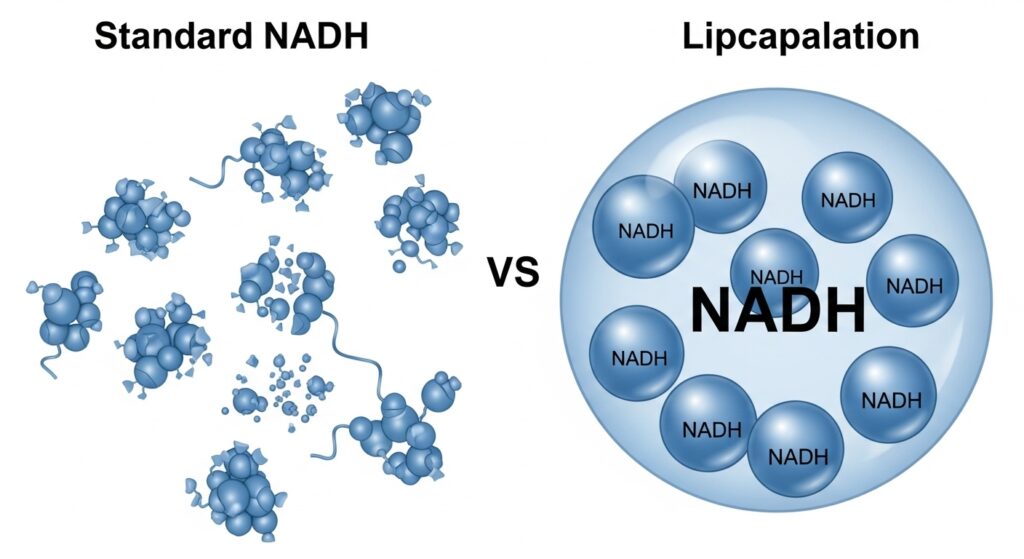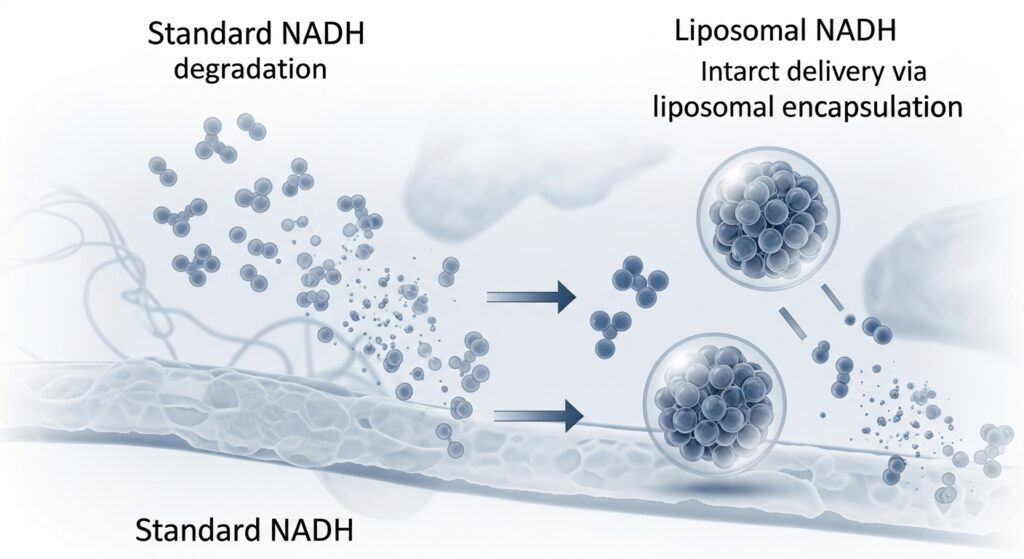Introduction: Why NADH Matters for Energy and Brain Health
Nicotinamide adenine dinucleotide (NADH) is a biologically active coenzyme form of vitamin B3 that plays a central role in the mitochondrial production of ATP—our cells’ energy currency. NADH is also vital for neurotransmitter synthesis, especially dopamine and norepinephrine, which influence mood, alertness, and cognitive performance. However, NADH’s full potential has been limited by its instability and low oral bioavailability.
Liposomal delivery systems are now emerging as a transformative solution for NADH supplementation. This article explores the science and benefits behind liposomal NADH and why it’s becoming a preferred format for energy and brain health products.

Limitations of Traditional NADH Supplements
1. Poor Solubility and Instability
NADH is highly susceptible to degradation from light, heat, oxygen, and the acidic environment of the stomach. These factors can quickly compromise its integrity, leading to minimal bioavailability and reduced therapeutic effect.
2. Low Oral Bioavailability
Even stabilized NADH forms are poorly absorbed. Research indicates that less than 15% of orally consumed NADH remains intact and bioactive after digestion. This results in insufficient elevations in systemic NADH levels to deliver measurable benefits.
📌 Supporting Data: According to Pieczenik and Neustadt (2008), mitochondrial dysfunction is linked to energy deficiency, and the efficiency of NADH delivery is critical in resolving such dysfunctions.
Liposomal Technology: A Smarter Delivery for NADH
1. Protection from Degradation
Liposomal encapsulation involves wrapping NADH in phospholipid bilayers that resemble human cell membranes. This structure shields NADH from environmental and digestive threats, including acid and enzymes, ensuring more NADH reaches the bloodstream intact.
2. Enhanced Cellular Uptake
Liposomal vesicles can be absorbed through endocytosis or membrane fusion, bypassing traditional transporter-dependent routes. This facilitates higher NADH delivery directly into cells.
3. Scientific Validation
Rodent studies have demonstrated that liposomal NADH can raise tissue NADH levels by up to 3.2 times more than free-form NADH. This indicates significantly better systemic absorption and intracellular utilization.

📌 Data Point: A study published in Pharmacol Biochem Behav (Rex et al., 2002) showed enhanced physiological effects of oral NADH with improved delivery techniques.
Key Benefits for End Users and Industry Stakeholders
1. Cognitive Enhancement
NADH enhances neurotransmitter synthesis, directly impacting memory, mental clarity, and alertness. In clinical trials, patients with chronic fatigue syndrome who received NADH experienced statistically significant improvements in cognitive performance and reduced mental fatigue.
📌 Clinical Evidence: Birkmayer (1996) reported improved memory and attention span in individuals taking NADH.
2. Fatigue Reduction and Physical Energy
NADH drives mitochondrial ATP production, which powers muscles and organs. Enhanced bioavailability from liposomal delivery may lead to more consistent energy levels and reduced fatigue—especially relevant for patients with fibromyalgia or CFS.
3. Targeted Product Applications
For B2B buyers, liposomal NADH enables innovative delivery forms like effervescent sachets, oral sprays, or liposomal capsules. These formats can appeal to both health-focused consumers and clinical wellness markets.
📌 Market Insight: According to Int J Pharm (Rakesh & Sinha, 2018), liposomal delivery systems are gaining traction in nutraceutical formulations due to their stability and scalability.
📎 Related Reading:
- Liposomal NMN vs. Liposomal NADH: Which Works Better for Energy?
- Understanding Liposome Structure and Uptake Mechanisms
Conclusion: Liposomal NADH Is Setting a New Standard
By overcoming the traditional limitations of oral NADH supplementation, liposomal technology marks a pivotal advancement in nutraceutical delivery. It not only increases stability and bioavailability but also supports more predictable outcomes in energy and neurological health. As interest in functional and cognitive-enhancing supplements grows, liposomal NADH offers manufacturers and formulators a compelling innovation.
References
- Pieczenik, S.R., & Neustadt, J. (2008). Mitochondrial dysfunction and molecular pathways of disease. Exp Mol Pathol, 83(1), 84–92.
- Rex, A. et al. (2002). Effect of orally administered NADH on blood pressure in rats. Pharmacol Biochem Behav, 72(1–2), 313–318.
- Mozafari, M.R. (2005). Liposomes: An overview of manufacturing techniques. Cell Mol Biol Lett, 10(4), 711–719.
- Rakesh, R., & Sinha, V.R. (2018). Liposomal formulations: From concept to clinic. Int J Pharm, 547(1–2), 20–36.
- Birkmayer, G.D. (1996). Coenzyme NADH – The energy enzyme. Ann Clin Psychiatry, 8(2), 99–109.